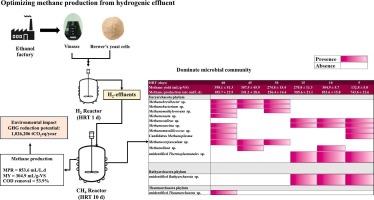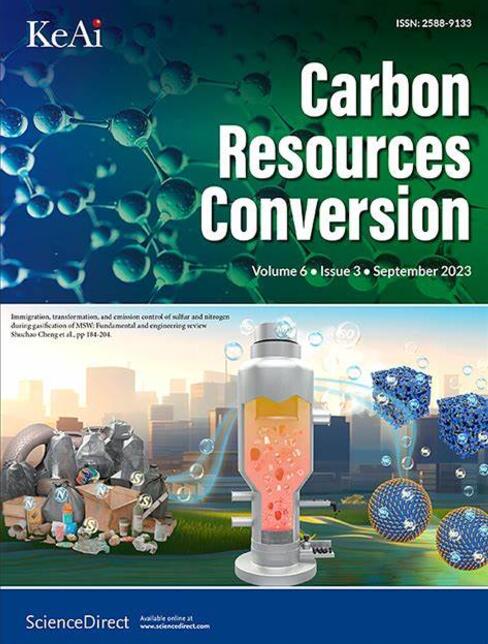Optimizing hydraulic retention time for methane production from the hydrogenic effluent left over from the co-digestion of vinasse and spent brewer's yeast cell
IF 7.5
3区 环境科学与生态学
Q2 ENERGY & FUELS
引用次数: 0
Abstract
This study aims to optimize the hydraulic retention time (HRT) for the methane production from hydrogenic effluent derived from the co-digestion of vinasse and spent brewer's yeast cells. The experiments were conducted in a continuous stirred tank reactor (CSTR) at various HRTs ranging from 60 to 5 days. The results showed that optimal performance was achieved at HRT 10 days. Under this HRT, yielding a maximum methane production rate of 853.6 mL/L·d and a methane yield of 304.9 mL/g-VS, with a COD removal efficiency of 53.86 %. The microbial community analysis revealed distinct patterns across different HRTs, with shorter HRTs (5–15 days) dominated by Bathyarchaeia-related taxa and Thermoplasmatota, while longer HRTs (30–60 days) showed the predominance of traditional methanogenic archaea within the Euryarchaeota phylum. The methane production process involved both acetoclastic and hydrogenotrophic pathways, with enhanced efficiency observed under shorter HRTs where both pathways coexisted. The greenhouse gas reduction potential analysis revealed that implementing this process could potentially reduce emissions by 1,026,206 tCO2eq/year through the substitution of fossil fuel-based electricity with methane-derived power.

优化酒糟与废啤酒酵母细胞共消化产氢废水产甲烷的水力停留时间
本研究旨在优化酒糟与啤酒酵母细胞共消化产氢废水产甲烷的水力停留时间(HRT)。实验在连续搅拌槽式反应器(CSTR)中进行,hrt从60天到5天不等。结果表明,HRT第10天达到最佳性能。在此HRT下,产甲烷量最大为853.6 mL/L·d,产甲烷量为304.9 mL/g-VS, COD去除率为53.86%。微生物群落分析显示不同hrt间存在明显差异,hrt较短(5 ~ 15 d)以深海古菌相关类群和热原菌为主,hrt较长(30 ~ 60 d)以Euryarchaeota门的传统产甲烷古菌为主。甲烷生产过程包括丙酮裂解和氢营养两种途径,当两种途径共存时,较短的hrt可以提高效率。温室气体减排潜力分析显示,实施这一过程可以通过用甲烷发电替代化石燃料发电,每年减少1,026,206吨二氧化碳当量。
本文章由计算机程序翻译,如有差异,请以英文原文为准。
求助全文
约1分钟内获得全文
求助全文
来源期刊

Carbon Resources Conversion
Materials Science-Materials Science (miscellaneous)
CiteScore
9.90
自引率
11.70%
发文量
36
审稿时长
10 weeks
期刊介绍:
Carbon Resources Conversion (CRC) publishes fundamental studies and industrial developments regarding relevant technologies aiming for the clean, efficient, value-added, and low-carbon utilization of carbon-containing resources as fuel for energy and as feedstock for materials or chemicals from, for example, fossil fuels, biomass, syngas, CO2, hydrocarbons, and organic wastes via physical, thermal, chemical, biological, and other technical methods. CRC also publishes scientific and engineering studies on resource characterization and pretreatment, carbon material innovation and production, clean technologies related to carbon resource conversion and utilization, and various process-supporting technologies, including on-line or off-line measurement and monitoring, modeling, simulations focused on safe and efficient process operation and control, and process and equipment optimization.
 求助内容:
求助内容: 应助结果提醒方式:
应助结果提醒方式:


